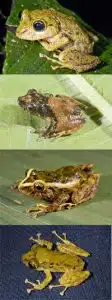Describing New Species to Science
Many of our photographs and specimens are as of yet unidentified. Some of these are likely species that are already known, but need more work to assign them to their correct scientific names — this is the science of Taxonomy. However, we have recorded 45 reptiles, amphibians, and insects that are so different from anything that is known, that they are good candidates for species never before known to science.
The animals you see here are potentially new species. Some of the frogs have combinations of particular diagnostic characteristics that make them good candidates, such as the pattern of color in the iris and tubercles (‘warts’) on the upper eyelids.
However, it will take much more work to formally describe these animals. This difficult work may include coordinating with world experts, performing DNA analysis, dissections, and call analysis. This task could not be more urgent. Indeed, we have to describe a species and give it a name before it can attain a protected status, such as “endangered”. But if we don’t do this soon, many of these species may go extinct before we even have names for them
But we can’t do this work without your help. If you too think this work is important, then please consider making a donation to make it happen!
Research Methods & Tools
Research Tools
Species Identification
New Species Descriptions
Amazonian Field Guide
Projects
We have a multifaceted approach to the science of Conservation Biology. We use everything from laboratory science to fine art photography to help discover, understand, and appreciate the value of biodiversity.
Support these projects by getting involved in our field work, or by making a donation today.
